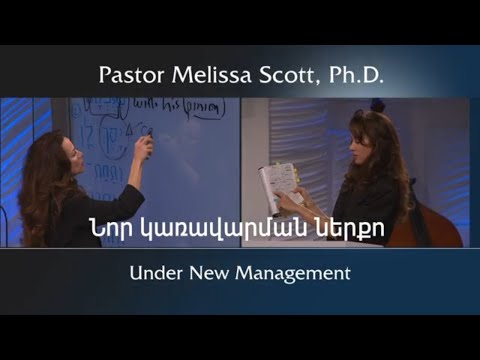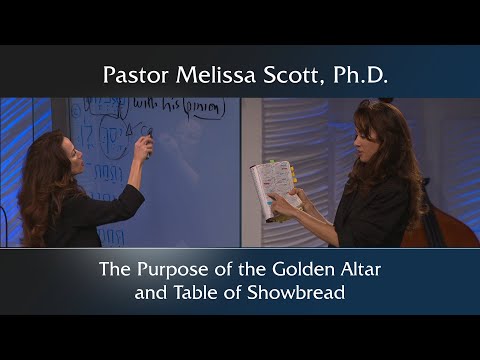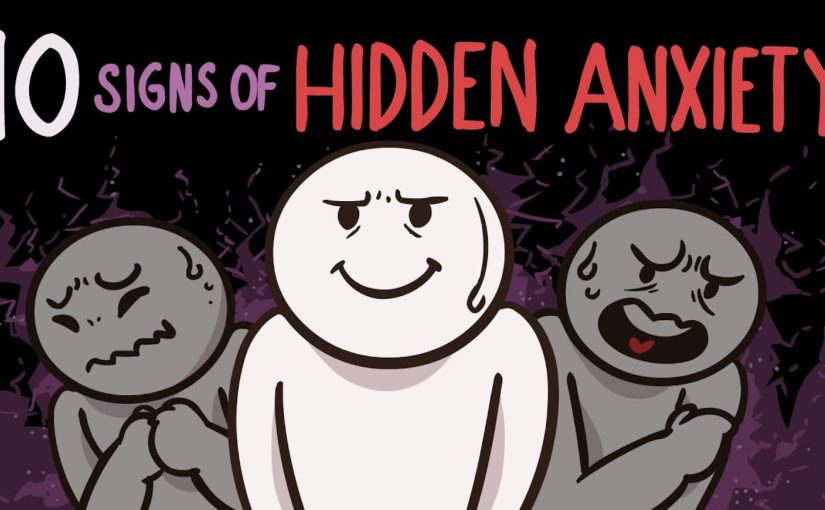I think it's safe to say when we talk about prayer and pray without ceasing in the context of the altar, the same concepts, I don't think it necessarily means that you are to pray in the sense of, you know, I'm going to lock myself in a room and for, for ten hours I'm just going to not stop praying. If you want to do that that's your business, but the idea is that it is perpetual, it's continual. That means whatever I might have prayed for yesterday, I may come back again tomorrow and do the same thing and likewise and so on. And I think that's where people get a little bit nutty. They think taking it literally, which is I will, I will pray without ceasing, I will pray at all times. No one can pray at all times, okay. Just get, get that idea out of your head. ♪ ♪ So we've been studying the tabernacle in the wilderness, its particular; its dimensions, its material, colors, the structure itself, and the furniture therein. And today I want us to turn our attention to the table of showbread, the showbread, and if times permits, we will move onto the golden altar.
But here is what's important. So this table, which you'll find in a diversity of places, but in Exodus, specifically the mention for the building of the table, which is sometimes called “the table of showbread,” sometimes called “the pure table,” when eventually when we get to Solomon's temple it will be called the temple of; “the table of gold,” but again, made of acacia wood. If you remember I said to you there's a translation from the Septuagint, which is the Greek version of the Old Testament, and if you read the Septuagint version of these verses and passages, they call the translation of the acacia wood is “incorruptible wood.” And I think that's really pretty cool.
Always overlaid with pure gold; and the dimensions of the table, two cubits in length, and if you heard me explain the cubit, from the elbow approximately to the length of the, we'll call it the middle finger would have been a cubit, so two cubits in length and one cubit in breadth and one-and-a-half cubits in height. And as I've said, the numbers always mean something. And I've done enough on the numbers that you could probably go back into the other messages and see what those, if you don't know them, what the numbers symbolize. I've already explained the gold, referring to Christ's divinity and the acacia wood referring to His humanity, which He was both all at once. So I love that these pieces of furniture, except for the candlestick, which we saw, which was pure gold, I like that everything in here points to a description. Which, by the way, think about this: God could have just said, “Make everything out of gold.” They had enough, by the way. Don't think they didn't have enough; they had enough. Remember, at some point God says, “Tell them to stop bringing; we have too much.” Remember that? So it's not as though they couldn't have done it some other way.
This was God's design and this is why you read in the New Testament, “See to it that you build it exactly according to the pattern.” Why, because there was built into that pattern, we'll call them the shadows and types that reveal and point to Christ. So this table had two, what are referred to as crowns, separated by a border and four golden rings, one at each corner through which poles or “staves” would be put through in order to carry that table when it was time to move. I also want you to keep in mind; obviously they wandered in the wilderness for forty years, so I want you to keep in mind that everything that God did here, pretty interesting that God saw this is going to be a moving event, perpetually. So the fact that everything is incorporated into the design is, is pretty interesting, because you know, if you think about it, we humans would go, “Okay, let's build a table,” but we wouldn't think maybe of putting the rings on for the staves, because we don't; it would be an afterthought. God included all this in the design.
So what I like about this is if you're reading about the table itself, when it says it has two crowns, there are three pieces of furniture mentioned with crowns, and I think this is not an accident either. The ark of the covenant has what's referred to as “crowns” on it, the table of showbread, and the golden altar. And I need to say something here, because I hope I haven't confused people, who don't maybe have this down pat. The brasen altar, which is outside versus the golden altar of incense, which is what we're talking about; I'm moving towards that, which would have been on the, in the same realm, if you will, of the candlestick, in that same area. So three pieces of furniture that had crowns on them, and what's interesting about this is these three pieces of furniture at some point we might take a bird's-eye view, but having these crowns, I thought it interesting that the table, in fact, has what I would call a double crown on it. And I don't think it's an accident.
Obviously crowns in this case, at this point in time, can only have two references. One would be to the miter that the high priest would wear, which was referred to as a “holy crown,” and that obviously of a king. And if you think about it, Jesus fulfilled both the high priest and kingly role, so when you read about, for example, two crowns on one piece of furniture, it, to me, fulfills both of those roles. This is a lot of, as I said, type. We're looking at types, but you know, if you look at all the furniture it is not a mistake.
As I said, the numbers, for example, we're talking about four corners in this case of the table, which I've already said in numbers, four corners of the earth, like we have four seasons or four quarters. These numbers are incredibly important. The same thing, this table is described as having four feet. Luckily it has four and not two. You'll get that one later. Again, balance, representing what will be presented to the whole earth or what's available to the whole earth. So I love all of these examples in type. But the table itself would have twelve loaves of bread weekly, basically. So these twelve loaves would be baked and placed on the table every week, and at a certain set time during the week these loaves would be replaced. And we know from different parts of the Bible there's an explanation that once this bread basically has been replaced, the old bread can be consumed by the priests.
So it's almost as though everything in the tabernacle has a purpose. There's really no waste. And as I said, kind of interesting, if you go to the book of Leviticus; Leviticus, for example, explains in just a few verses about the showbread. Leviticus 24 says, “Thou shalt take the fine flour, bake twelve cakes thereof: two tenths deals shall be in one cake.” And you see, even that you might think, “Well, why is that important: 'two tenths deals shall be in one cake'?” I'll tell you in a minute. “Thou shalt set them in two rows, six on a row, upon the pure table before the LORD,” there it is. It's not called “the table of showbread,” but “the pure table,” right there. “Thou shalt put pure frankincense upon each row, that it may be on the bread for a memorial, even an offering made by fire unto the LORD. And every sabbath he shall set in order before the LORD continually, being taken from the children of Israel by an everlasting covenant. And it shall be Aaron's and his sons'; and they shall eat it in the holy place: for it is most holy unto him of the offerings of the LORD made by fire by a perpetual statute.” So it's kind of interesting this bread, baked every week, but the two tenths deal kind of got my attention, and why is that? Because if you read some of the other places where you find this “two tenth deal” for, for example the meal offering in the feast day of the sheaf of the firstfruits was to be two tenths deal of fine flour.
The wave offering, for example in the feast of Pentecost, the same thing: two tenths deal of flour. But the manna that was to be gathered on the sixth day of the week, you would actually end up with a double portion, because you had to gather twice as much, because you were not allowed to gather on a set day that was set aside where no gathering could occur. So I want you to think about this. It's equally interesting that the twelve loaves, inside each loaf basically would contain a double portion.
And that might not hit you right away, because the loaves are a little bit tricky to explain in their type, in their meaning, but I'll, hopefully I'll get to it. And then you come back to the understanding of the manna. And the manna has, I think, kind of baffled a lot of people. And I say that because, think it, think of it this way. God rains down this light bread, which the people, after they murmured that they were hungry, right, God rains down this light bread, the “what-cha-ma-call-it,” right, gives them instruction on how to gather, what basically what to do with it, and so forth. And one of the stranger things is when the instructions are given to gather up manna and put it in a pot that will be placed inside the ark, along with Aaron's rod that budded and the unbroken tables of stone, but what's strange is those, that manna that's placed inside the ark is, it's called something, we'll call it continuous or perpetually contained in the ark. And we'll say once the lid or the mercy seat was placed upon the ark, covered and not seen anymore.
And I've said this for many weeks now, with people asking, “Where's the ark?” When you read in the book of Revelation, and I believe it's in the second chapter, it talks about “To him that overcomes I will give to; to him I will give to eat of the hidden manna.” That's why I said to you be very careful to not exclude Scriptures that tell you that God had a purpose in taking away the ark. So think about that. While all of these mystery hunters out there think they're going to solve the problem and it will be an “Aha moment,” uh, okay. Knock yourselves out. So with that being said, I also read here about this frankincense that would be placed upon the loaves. And then of course, these loaves would be replenished weekly. Now, frankincense, there's kind of this shades of meaning. It can be representing holiness, righteousness, truth, even deity.
But if you recall of the gifts that were brought to the Christ child, it was gold, frankincense, and myrrh. And we know that there in those offerings we see a type again. The gold obviously was representing His divinity or His deity, the myrrh in preparation for His death, and the frankincense we can kind of ambiguously say either sweet savor, sweet aroma to God, but also His righteousness. There's a whole━there's kind of that. So applied to the bread it becomes, well, what would be the purpose if the bread, by the way, is going to be consumed by the priests? But it's, it is consecrated bread, in some places called “consecrated bread,” other places called “hallowed bread.” So why would God have them put this frankincense on there? And I think a lot of times there's, there's all these little nifty things we can read about, but the frankincense could also serve as a form of preservative.
So imagine, you know what happens when you leave something out, especially bread. What happens after a week of it being exposed? It's nice and hard, right. So I'm assuming that the frankincense actually had a preservative-type action with the bread. There's something else that's equally interesting about the bread. We read that the bread was pierced. And I think that's interesting, because the bread had to be pierced in order for it to rise.
Do I need to explain that one? That's pretty━okay, but I'm going to do it for the sake of the people that say, “Okay, well what? What the hell did she just say?” So if the bread, remember this I said it's tricky, because the bread is actually an offering out of God's provision from, basically from God, the people take it, and then the people bring it back as an offering to God, right. But so it has multiple, we'll call it, it could have at least two or three meanings or two or three interpretations.
So the bread being pieced, as I said, if we call Christ, as He referred to Himself as “the bread from heaven,” or “the bread of life”" that Bread of life also had to be pierced so it could rise. I love these little━they're very simple, but they're very clear. It's almost like God's saying, “Can you hear Me now?” right. All right, the measurements of the table, as I've already said, the height is one-and-a-half cubits tall, the same as the ark of the covenant. And this is important because the table being the same height as the ark, where the bread would be placed, puts it on the same level, if you will, as the mercy seat.
So the redemptive act where the blood would be sprinkled and applied would carry the same value in height as the bread placed upon the table. And this kind of is important to understand, because the bread may also be considered representing communion or fellowship with God. So if you think about it, the redemptive work of Christ and communion with Christ kind of go on the same level as the measurements depict. It's one of those things that if you're moving around you see that every detail here points to something. God didn't waste a crumb; pardon the pun. All right, there is I said, I mentioned a crown around the table; two crowns, in fact. And I love this, but be very careful about how you interpret what I'm about to say, because I know a lot of people will go far with this one. The crown around the table may have had a practical purpose, and that practical purpose may have been from keeping the bread from slipping off the table. Now if you go back to what I said about our two crowns and the full fulfillment of high priest and king being fulfilled in Christ, then Christ does help us, but unlike the bread that doesn't have free will, we do.
So we can slip and fall, if you will, off of God's table. All right, don't make the mistake. This is, again, one of those things denominationally speaking that some believe “once saved, always saved.” I do not preach that and do not believe that. I have seen more people in my lifetime, some very impressive, brilliant minds for the Lord, they were incredible, they made incredible contributions in ministry that fell away.
And then the people that believe in the doctrine of eternal salvation, “once saved, always saved” will say, “Well, they were never saved in the first place.” That's pretty hard to actually remedy when you look at some of the writings of some of these people who spent thirty and forty years of their life studying the book, preaching the word, and for whatever the events that happened fell away. So I, I don't think that this crown around the table, we can't go too far, as I said, because I don't believe in “once saved, always saved,” but it did have a purpose. And I'd say if you want to take this and make it something that could be applied, looking to the crowns, the high priest and king, can help you.
It doesn't mean it's going to stop you from slipping, but it can help you, and I, I'm just going to leave that there. The bread, sometimes called “the bread of faces,” the bread that would be placed before God, bread, lechem, and pânîym, so it's interesting. The bread of faces, if you translate the word “showbread,” just the word “show” from our English going back into the Hebrew is “to say,” or “to declare.” So it's, it's kind of a strange thing.
I'm not even sure why or how that came to be, but that's what it is. Sometimes also, as I said, referred to as “the continual bread,” and I like that. Remember that each one of these in proper context, the continual bread, which would mean the bread never ceases, even though the manna stopped the bread never ceased. If the bread for us is Christ, He is everlasting and ever liveth, so you can take that how you want. If you remember, there is a passage where David is fleeing for his live and runs in. He finds the priest and he's asking for two things: food and weapons.
Do you remember that? Okay, when he asks the priest, the priest says, “I only have hallowed bread here; not common bread.” And I like the fact that just in that one distinction it lets us know this is no ordinary bread. The priest did not see it as ordinary. Even though it was bread, it was not considered common or ordinary. And again, if you're going to keep going back to these references of Christ, who is the bread of life, no ordinary situation here in Christ either. So all of these, as I said, have great meaning if you're going to comb through the furniture here. The bread, as I said, represents both an offering; and this is where it get complicated and I'm going to try and do this as clearly as I can, but it's difficult, because the bread is, yes, an offering from the people to God, but let me take a little pause right here.
There are too many places specifically in the first five books of the Bible that talk about offerings and giving that explain something that if we all just kind of took a minute to process this, there would be no confusion here. Even that offering from the people to God came out of God's provision to the people, and if you think about it, every single offering that God along the way asked, whether; it didn't matter, it all came out of the provisions that God provided. This is what is frustrating to me as, as a preacher, but also as a person of God. I don't understand this.
And maybe someday, someone will come and argue and enlighten me on this, but I don't understand. If it's as clear as day here that God multiple times over gave to the people, in order that they could give back and participate in worship. What does that tell you about our response? I don't care what you've been taught; what does that tell you about our responsibility, first in recognizing who the Provider is, where the provisions come from, and why we need to be givers? It really kind of; you know, think about this. Have you ever given something to somebody, and we're just human flesh pots, but have you ever given something to somebody and they don't even say, “Thank you.” They don't even━it's like someone who's entitled.
They don't even recognize the gift that was just given to them. And you don't do it because you're expecting “Thank you” or recognition. Now put that on steroids. God, who has given us our faculties, our abilities, the breath in our lung, and yet; lungs, and yet people will still make this an argument. And I think probably this year for me has been the most crystal clear on this subject. It's not discussable. It never was discussable. For all the people out there, for all of you out there who still play this game of “Well, I don't think it's necessary,” or whatever it is, you're just deceiving yourself, because if I'm showing you the patterns that God put down here, not just the patterns of Christ and everything that points to Christ, but also how we are to relate to God. And even, remember I told you a couple of weeks ago, the approach to the tabernacle, those white curtains, right; think about this. Before you came into the church you might have been thinking, you might have been, you know, wondering about God, but then if you're like me, I stayed away from the church.
And I stayed away from the church, A) because I left the church long ago and out of, from a myriad number of reasons. But I also in my mind thought I couldn't possibly be accepted into the mix. So those white curtains still exist today. They're for any person who hasn't come to know the door that you must go through or the sacrifice that was made or the laver of cleansing; all of these things help us, including the structure in which God organized it. See, too many people focus on this idea of the tithe, and not enough focus is given here on who gave to be able to make you a giver. Think about that. Cain and Abel; who, who provided the offering for them? Who? And you keep going and you recognize all the way through it, every juncture it's the same thing. So what happens when we come before God? And I'm just going to say it like this, because the Bible talks about coming before God empty-handed.
What does it say? It says, “I completely deny that You ever provided for me in the first place.” Sorry, but if you can't see that you may not have the Spirit of God in you, because that's exactly, without telling somebody how much you need to give, but rather what's underneath it all. What is in the person's heart? Failure to recognize that, you can't━it doesn't matter what you take out of your pockets afterwards, it's all going to be works of the flesh, an endeavor to check a box and not see how God has laid this out crystal clear. So just put a little period right there, because that tells you my take.
Again, every week I'm going to maybe hammer on this. My take on giving is not some optional ideology or let's describe a percentage. Let's start with the right first place here. Every place here we're looking at, so the, the bread placed on the table, as I said, the oil in the lamps. And yes, there are two distinct types of oil; it doesn't matter. Again, the people had to gather it and bring it and produce it. So you've got enough there, all of the material that was required to build the tabernacle: all the threads, all the gold, all the silver; all of it, where did it come from? You could say, “Well, they came out of Egypt and they basically looted the Egyptians as God told them to do.” That's a good obedience right there. I mean, you know, we, we got people thinking they're coming out of Egypt in San Francisco and Sacramento all day long. That might; you'll get that one later.
No. All right, I was meaning in the looting part there, okay. So don't say, “Oh, well, it's biblical! I just went into whatever place to rip it off because it's biblical.” No, this is━but I'm, what I'm trying to show you is even there God made a provision and said, “Go get it from these people,” and there was a reason for them. Obviously, God didn't━think about this. God said, “Go get it from these people and take it from them as you go.” Why? If God wasn't planning to have this, all of what they took be a part of a pattern to build, then they'd just be a bunch of rich, heavy laden wanderers in the desert and with no point.
So again, this kind━I, I hope I've killed that one and it's clear. So I said the bread is complicated, because the bread, as I said, as an offering the bread can also be a representation, as I said, of Christ as I described that the bread being pierced in order for it to rise. So there, there could be multiple ways to interpret this, and I'm not going to get dogmatic over which one to go with.
They both embody the concept that I'm trying to convey. Twelve: the number of loaves that would be placed there every week, and replaced weekly; this number, as I've pointed out reoccurs over and over again. You've got the twelve tribes, you've got the, the twelve disciples. So twelve in this case, the number of divine government, which kind of is the pattern we're going to see spread throughout. Some people have labeled twelve as apostolic fulfill-ness or fullness, if you will. I, I'm just going to say I prefer to say divine government. It, it takes care of everything here. The number twelve also is carried into the heavenly city with its gates, if you think about it, twelve is everywhere in the Bible; twelve foundations, twelve precious stones, so not an accident in terms of the number.
I love the fact, by the way, that if you look at some of the references of twelve, like the twelve stones that Joshua took where the waters were basically arrested so that they could cross over, or the twelve stones of Elijah. Again, probably more of a mystery to me, the twelve stones of Elijah, because we're dealing with 1 Kings 17 or 18, where we're just starting to see the fracture that is beginning to occur within the kingdoms, and yet God didn't say, “Pick up two and ten.” He said, “Twelve”" there were twelve stones.
So again, with all of the separation we know that will occur, God's language is always going to be united; multiple parts, but united within. And I like that too. There's a mention in the table that might not make sense, and it says that there was a “border of a handbreadth between.” So I want you to think about this. Think about the table itself, and then almost a table within a table, so that you can understand what the border might be. And that border of a handbreadth, this is a tricky one, because no one is quite sure. And trust me; I went to some of my Hebrew sources. No one is quite sure what to make of the proper interpretation of this word, because it's so ambiguous. But I'm going to go for how I understand it, almost as the word connotes “fortress, safe place, enclosure,” a “handbreadth.” So I'm going to say that that concept basically separates. In other words, there is a ledge that is probably designed for the placing of utensils.
The table came with spoons and bowls and other things, so probably that area might have been to put some of those items on. That would have been enough space for it. But I'd like to say that the interior, what we'd call the interior border or that interior walled-off section was a way of separating. And I like this because it, it reminds me of a very strange, it's a very strange analogy I'm going to tell you right away. But if you remember, in the book of Ezekiel, God's describing the city, and He's taking Ezekiel through every part, and He says once He's finished in one area He takes him outside, and He mentions, in the Hebrew━you won't see it in English, but it's the same concept of a hand, hand's breadth to denote separation from other things coming in contact with other things.
So I think that's interesting that God put that there on the table. And whether that is to suggest the bread, if that is possible, being separated out, which it was, it wasn't common bread, or whether that is to represent those people who could approach the table, who were separated out, the high priests. But in any case, it denotes a form of separation, which I think it's like saying this bread is specific and not everyone is invited to partake and to touch, okay. And you might say, “Well, that's kind of unfair.” Well, whoever said it was fair? All right, I think I've probably covered enough on that to talk about, so why I say the separation of the bread is because within all of these pieces of furniture you're also going to find different concepts theologically that we talk about in the New Testament.
So I believe that part of the design of the table, you know, I just used the word “separation” or to keep out would represent what we would call in the New Testament “sanctification,” a separating apart. So kind of just put that as an important thing. And then I love this. In the realm of the tabernacle God basically says, I read it to you that Aaron and his sons, they shall eat it in the holy place. So God made a provision for the people who would be serving and doing the work of basically everything that was contained within that holy place.
Now we don't have a designated place anymore, but I love the fact that right there it basically says God provided. You know, bread is always interpreted as “the staff of life.” God provided for those serving Him the ability to partake. Now take yourselves right into the New Testament. We are a royal priesthood. There is no priests; Jesus is our high priest. But again, this comes back to provision.
And I believe this wholeheartedly. Someone who serves the Lord; and don't just say, “Oh, are you talking about being a pastor?” No, I'm talking about anyone who serves the Lord; you are a servant in your own home. You are a servant unto the Lord when you come here and you do whatever you do, if you do it in the name of the Lord that the Lord provides. And this is another one of these built-in messages that says to me when it says, “And Aaron and his sons, they shall eat it in the holy place,” as if to explain to us that anyone who's going to be committed. You know, there's another Scripture that says, “I have never seen his righteous ones begging bread.” Well, I've seen people begging for bread, hungry, okay. And that doesn't mean, no, they didn't serve. But I'm talking about I have yet to see God abandon the hand or the mouth of someone who is committed to serving, why, because God knows what's in your heart.
That's not to say that God's going to put out fillet mignon for you every night, but it's simply along the same lines of the Lord knows exactly what we need. And if bread is the staff of life, I'm going to go beyond the provisions of food to talk about the provisions of the total person, which come to us in the form of Christ. Again, everywhere you turn it's like mirrors that keep reflecting Christ throughout this whole tabernacle.
It's inescapable. And that's what I love about these studies. You cannot, if you're reading the same Bible I'm reading you cannot escape these types. And they tell me something. They over and over and even deeply or deeper every single week tell me God did not make━there were no accidents here like, “Oops, you know, I just, I decided I wanted this.” No, they're very deliberate. When I talk about these things, and I just mentioned the vessels that would be used in accompaniment with the table, the vessels were set apart for a specific purpose. You'd never see the flagons or the covers or the spoons being used for something else. They were specifically used for service at that table and nowhere else. And that tells me just like each and every one of us as vessels, we have a unique purpose.
That doesn't mean that we can't do multiple things or multitask, but we have a unique purpose in God's plan. And again, I, I think the concept, the question that's asked, you know, “Could God set a table in the wilderness?” Well, of course He did. And this paints the picture rather clearly, not only was this a table of fellowship and communion, but if you think about it, from the very beginning where they would have to go and gather the manna, I want you to imagine what that must have been like, all right, because God gives a specific command for how much they can gather and when they can gather and how they can gather it. So from start to finish God provided opportunities for the people of God to participate. Now I'm going to stop right there and ask you a question. Why is it that, fast forward into the New Testament church world and people think, “There's nothing for me to do”? I'm not talking about works.
I'm just saying that if you look even at the pattern of how everybody participated, each had their own. I said this last week. Some people were responsible for gathering the olives to make the oil, some people were charged with gathering the manna, some people were charged with the craftsmanship, but everybody did something that brought the whole camp to be involved. So think about these things, because I think it's pretty important. Now, when it came time to move the table, like other pieces of furniture, God provided the covering. And it's the same covering that I described, more or less. You've got the table that would be covered with a blue cloth that would be underneath it all. And of course, I've already blue, the color of eternity. The dishes, spoons, and bowls had a scarlet covering on them or red covering on them.
And the final covering would be badger skin. And I always like this because even the last time I mentioned this, people were like, “What the hell is that?” But think of it as the ugliest nondescript covering that you could have; nothing to look at. And this is what I love. To the natural eye, to the person in the flesh, if they saw the badger skin it, it would almost probably be repulsive. They would say, “What? What? How could that be holy?” because, you think about it, look at the complete opposite here. The complete opposite when people think of “holy” they think of opulence and they think of grandiose.
They think of the Catholic Church with its pomp and splendor and all the ornate-ness, right? You don't think badger skin. Badger skin is like, “Yuck, that's repulsive” to the natural man, to the natural eye. But someone who can look at this and really understand the meanings of these coverings, you're seeing what we'd call the, the, what the Bible refers to in Isaiah, speaking of Christ: there was no beauty in Him. So one has to look at the covering, and if it is with the eyes of the Spirit, you can see beyond the badger skin down to the blue and see the eternal purpose. But someone who doesn't have the Spirit is going to look at this and say, “What is this? This is like a junkyard with all kinds of stuff being transported, covered up with all kinds of”━it's like going to Grandma's house with all these different coverings on everything, right? What the heck? All right, so I think I've, I've given you enough of the picture of this table and its, its purpose.
I'm going to move on to the golden altar of incense, which was also in the holy place, as I realize if I keep going at this speed we will never get out of the tabernacle. So this piece once more, acacia wood overlaid with pure gold, sometimes called “the altar of gold before the throne.” There is that reference, by the way, in Revelation 8:3. I want you to ask yourself the question, why are there references to articles of furniture or concepts that were in the Pentateuch that appear in the book of Revelation if it's not because God is saying, “That was a shadow; I'm showing you what the actual substance, the tangible substance is now”? That's what will be revealed, the real thing.
So as I said, the altar before the Lord, also called “the altar of sweet incense,” it's dimensions, one cubit square and two cubits high. And I think this is pretty interesting myself, because that right there, one cubit square, means it was a square. It was square square. And I don't, again, I don't think this is an accident. If this golden altar, being probably the tallest or greatest in height of the table, of the ark of the covenant, or whatnot, the interesting thing here is that you have the shape. The shape brings me back to something pretty important, the, the city that is described as foursquare, the city that's yet to be, the heavenly city of Jerusalem described as foursquare. And again, the interesting relationship to the other pieces of furniture, what this particular altar, we call it the altar of incense; incense would be burned upon it, if you will. That altar represents for us what we would call another form of communion, prayers ascending to God, in the New Testament form if you will.
This golden altar had horns on each corner, a crown molding of sorts, gold around the edges with two rings of gold underneath what I'm calling the “crown molding,” which would kind of be a decorative something that goes around the exterior square. This altar would be found just before the veil. And I want to make sure that I make this really, really clear, because I know there'll be people that will be confused about this. So the difference between the brasen altar, which is further back, go back towards the entrance, all right. And sometimes I think people confuse the brasen altar with the golden altar. So the brasen altar is where the sacrifice for the sinner was offered. We call that judgment, we'd call that everything that you want to look at in terms of the act required to redeem or to forgive the sins of the sinner.
And you cannot, you would not be able to approach the altar of incense without having made or seen the sacrifice. So in translation for us, you come through the door to see the sacrificial and finished work of Christ, and when you are able to see, understand, recognize, no, and it doesn't have to be perfectly, but with that focus, then you approach and the incense of prayers can ascend. You know, people say, “Well, can I just pray?” Well, who are you praying to? So there, there is a pattern with purpose here. It's not just simply, “Okay, I'm going to go through the motions and check the box.” There was actually a method to this. Also, once a year on the great Day of Atonement, Yom Kippur, they'd also apply blood onto this altar as well. In fact, I think everything got blood-covered. The blood obviously being a picture of this sacrifice accomplished, and so the foundation of worship therefore and praise was going back behind what was already done, the shed blood that was already shed.
So again, none of this would have━do you realize if I wasn't giving you the other side, which is showing you Christ, it just kind of sounds like, “Well, what's the purpose?” because you'd have to repeat this every year, and some of this you'd have to repeat every day or every week. What's the point? So again, that's why I said to you, you cannot read this without seeing that God actually had a vision to carry out the fullness of His Son, but these all point in that direction. The incense, this is another interesting one, made of four sweet spices in equal amounts would be blended and burned, produced fragrant odors or perfume.
One of these spices, the Hebrew word nâtâph, “to drop,” or “to distill,” a balm, which suggests fragrant outpouring of a life yielded. It's kind of interesting if you look up that word. The second one is a little bit more strange, because the second ingredient would be, would come from a shell or a scale that would be ground down into a fine powder. They'd find this shell around the Red Sea. It sounds a little bit weird to grind down a shell, but when finely ground it would produce a very fragrant perfume. Some scholars have equated the, this kind of incense, the full compound of the incense with a complete dedication or devotion. I'm not sure that I want to go that far, but it all has meaning. The next ingredient was a sap-like substance called, “galbanum,” which is purported to have medicinal properties. And finally frankincense, which you can see frankincense would have a place almost, almost throughout the whole tabernacle.
Our English word refers to its fast and free-burning qualities. Frankincense as a medicine or antidote to poison in some cases, equally like that, it's kind of interesting, but it could also be used if you remember I talked about it being put on the bread as preservative. It could also be used in the context of purity. So remember that this consecration would also be like the memorial of the meat offering. So all of these ingredients, they are, it's not just one time that they appear. They appear in different places and I believe they all have a part, an important in; we'll call it the recipe and the formulation that God put together. So you put all these ingredients together; they're blended for one singular purpose to be put on the altar of incense, and then obviously it is something that ascends.
Now we are not burning incense, but that altar does represent our place of prayer, the prayers going up. And Christ, who is our high priest, would pass into the holiest place of all to obtain that eternal redemption for us. So it's, again, nothing can be done, it's weird, like everything is connected. You can't even start understanding all of the furniture, unless you come through the door; sorry, okay. And once you come through the door, that one singular door that brings you in from, from being outside of those white curtains, once you come through the door and you begin to see this furniture there must be an understanding of the purpose of the why.
And for example, if one was just going to stand at the laver of cleansing, we'd say, “Well,” as I pointed this out, we're washed and cleansed by the word of God. Each one of these has a connection. And the more you look at this━I'm just giving you a very generic picture. You want to knock yourself out, if you can read Hebrew or you have access to a Hebrew Old Testament, look up some of these that words I've talked about just in reference and you see, wow, there, there are deeper meanings to these words.
I'm trying to keep this generic, because I realize that I'm describing furniture, which you might say, “Well, a message on furniture; okay, interesting.” As I mentioned earlier, I believe the coals that came off of the altar of burnt offering were used on the golden altar as well. And God was very particular about this. If you remember the episode that happened with Aaron's sons Nadab and Abihu, remember where they took false fire, right. God basically warned them, by the way, it wasn't like they just stumbled upon and said, “Oh, let's try this.” God said, “Do not use strange fire,” meaning if there was a fire that was perpetually burning, that is from where you get the coals or whatever for whatever you need; you don't go and get it elsewhere. So I like the fact that God's very specific, even right done to the fire, when He says, “This is what I want you to do and this is how I want you to do it.” Of course, their disobedience and their blatant disregard for God's instructions and God's ways obviously cost them their life.
You have a similar scenario that plays out with Korah and the rebellion of Korah; not so much over fire, but the idea is still there, direct denial of God's chosen way, direct denial of God's way of approach. And of course, the same thing with Korah and Korah's band, it cost them their life. And my only lament is why God is not opening the earth up nowadays and swallowing people up, I don't know, but 250 men that followed Korah were consumed, completely consumed. So I think it's safe to say with God obedience is better than sacrifice. Let's leave that one alone. But what's unmistakable here about this altar is if, as I said, if the brasen altar was where satisfaction was made to the holiness of God for the sake of the sinner, then the prayers being offered by the saint are what are seen essentially in the golden altar of incense, accepted, by the way, because of the sacrifice that was already done. So I like to put it this way. If the first altar, the brasen altar flesh is sacrificed, here at the golden altar of incense you have basically the soul; if the flesh has been sacrificed the soul is communing with God.
So those are the two pictures that I like to use as a New Testament appropriation. I have one final thought here on, on the altar, on the golden altar, which is Aaron was instructed to offer a perpetual incense upon it. In the New Testament we are told by Paul to “pray without ceasing.” And this becomes a stumbling block for a lot of people, because the idea I think a lot of people think is, “What does that mean? Should I lock myself in a room and I, I pray and I pray and I pray and I pray and I pray, and I keep praying? Or I pray redundantly? Or I pray from a card? Or”━no, it doesn't mean that. The picture that has been depicted here, and I want you to think about this, if the offeror, in this case Aaron, was told to offer perpetual incense, then think about this.
What he brought, whatever those four ingredients were, had to be basically consumed before he would bring and replenish more. So I think it's safe to say when we talk about prayer and pray without ceasing in the context of the altar, the same concepts, I don't think it necessarily means that you are to pray in the sense of, you know, I'm going to lock myself in a room and for, for ten hours I'm just going to not stop praying. If you want to do that that's your business, but the idea is that is perpetual, it's continual. That means whatever I might have prayed for yesterday, I may come back again tomorrow and do the same thing and likewise and so on. And I think that's where people get a little bit nutty.
They think taking it literally, which is I will, I will pray without ceasing, I will pray at all times. No one can pray at all times, okay. Just get, get that idea out of your head. Not even the people who profess to pray all the time pray all the time. At some point you've got stop for some bodily functions here, okay, and I don't think that while you stop for that you're equally praying at the same time. Just save it for somebody who might believe you. All right, so I just want to say this about everything, because I've kind of done a very more generic approach here.
But these concepts, the table of showbread and the golden altar of incense, they do represent something to me that I think is desperately needed in this particular time, and that's called communion with God. And this got me to thinking a little bit, especially with Easter coming up, and I'll just tell you straightway in advance, because I was having a conversation with somebody last week, and I said, “You know, we have enough Resurrection, proofs of the Resurrection, different approaches to the Resurrection, many, many years of, of these messages.” But the application, it dawned on me; I think a lot of people don't actually know how to apply the resurrected life into their lives.
And that actually requires communion and fellowship with God to understand that. So when we look at these items you don't look at the table of showbread and the altar of incense without, as I just finished mentioning without all that came before. And recognizing just even how you came into the tabernacle, how the way of approach explains that without recognizing and understanding; you don't have to be a mathematician and understand formulas, but you do have to look at the big picture to recognize your standing of who you are before God, which as a sinner. We're all sinners, there's not one person in the sound of my voice who isn't.
We are sinners being basically washed and cleansed by the final and finished sacrifice of Christ, washed and cleansed by the word as He described in John 15. But all of this kind of comes down to a bigger picture, which is how do we understand this in fellowship and communion? Because it is in the fellowship and communion that the relationship is developed or built, it is a relationship. And you can't have the relationship just simply built on what I just described, the table and the altar of incense without recognizing the sacrifice, the way of approach, the way in, what walled you out, what kept you away.
And that that wall of partition has been broken down. But all of that is to say that when I do get around to, I believe next week is Easter, it may not be a traditional proofs of the Resurrection, because it dawned on me in all the years, my 18 going on 19 and probably 30 years of Dr. Scott's ministry here, I don't think I've heard a message on why it matters to understand about that resurrected life and how to apply it, because there begins the concept. See, I think a lot of people come in and it becomes it's an obligation for one day, “Okay, I've got to go because I know this is kind of a commemorative thing.
I go because, and here's all the reasons.” But there all the wrong reasons, because if you come to understand the proofs, and the proofs properly applied to your life bring something incredible to the believer that without that you may just say, “Well, it's enough for me to know, because Christ resurrected sits at the center.” But the lack of understanding, in my opinion, brings about a lack of communion, a lack of fellowship, and a lack of worship. And those things that are lacking keep the distance, in my opinion, between the believer and God. So hopefully we will, I'll get to that next week and I'll talk to you about that next week, but what I want to say in wrapping up; I'm not done in the tabernacle by any means. But I wanted to keep this simple because, as I said, showing each measurement or each color or each dimension is it, it's there, so you can go back and read the descriptions of the table and read it for yourself or the descriptions of the altar of incense and read it for yourself.
And understand now with the understanding of what is, what is a cubit and what the numbers mean or that the materials mean. But go back and read it, as I've said for many weeks now, looking at through the eyes of God in Christ, looking at how amazing God is to paint this picture. And the picture as I said, wasn't painted for a few people. That's why, again the numbers matter.
This four corners of the earth, to all ends of the earth; it wasn't designed for a singular people. This is the mistake that people get into when they say, “Well, this was given,” and I've heard people say this, “This, this was given to the Jewish people.” No, the Jewish people didn't exist at this time. I've already gone through that, and please, if you haven't listened to my message do not argue with me, do not post on my social media page. If you have not listened that means you are still ignorant as to what this book; not me, not my opinions; what this book says about what I just said. This was given as a pattern of what God would do for the whole earth. And when you come to see that it just makes God and His plan of salvation all the more amazing, because He said, “I don't need for people to keep coming to the door perpetually and slaughtering an animal anymore. I chose My only begotten Son,” and He gave His life that you and I may have life eternal.
And that life eternal is something so powerful in, especially in this day and age where people are vacillating in fear and confusion and everything else. This resurrected life says, “No matter what's going on, God has a plan.” He had it here, He had it here, He had it here, He has it here at the end of the book, and He's got it here and He's got it there. And if you just look it will bring something else to your life: peace. And without that I don't know how you're going to get along in this world, in this crazy lunatic world right now. So with all that being said, I hope that you can take what I've said today and without it being too detailed, very generic, to say there is definitely reason to go back, reread and study, and see the beauty of Christ in the Old Testament. That's my message. You have been watching me, Pastor Melissa Scott, live from Glendale, California at Faith Center. If you would like to attend the service with us, Sunday morning at 11am, simply call 1-800-338-3030 to receive your pass.
If you'd like more teaching and you would like to go straight to our website, the address is www.PastorMelissaScott.com.
As found on YouTubeWatch The Video Below To Find Out How YOU Have Been Programmed To Study The Wrong Way All Your Life And Because Of This YOU Have Achieved Far Less Than What You’re Capable Of!



 6. You overthink past conversations. You tend to get hung up on past conversations. No matter how much time has passed since then You analyze the other person,’s, body, language, facial expressions, choices of words, and even the tone of their voice. You can’t help but think about what you should have done or said instead and it drives you. You are crazy and keeps you on edge every time you remember it. 7, You’re, always making yourself busy It’s common for people with anxiety to have a strong need to keep themselves busy. They’d like to occupy themselves with simple tasks and do as many things as possible in a day because sitting still and doing nothing for a long time can make them feel restless and on edge 8. You talk yourself down all the time. Life is 39. T is always kind to us and has self-love and a balanced lifestyle. Doesn’t come easily Living with anxiety, especially if it’s hidden or suppressed, can make it hard for us to feel good about ourselves and let ourselves feel happy. It makes us believe that we don’t deserve it and traps us in a vicious cycle of negative self-talk and constant pressure to be perfect. 9. You have a lot of negative thoughts. Are you a pessimist whose quick to find the downsides in every situation? You find yourself getting upset or stressing out over it. Even the most minor inconveniences Are every day, a constant battle with yourself against the spiral of panicked and rational thoughts. You have In 1997, famed psychologist and cognitive therapist Aaron Beck termed this kind of thought pattern as catastrophic thinking Which he often observed in his patients, who suffered from anxiety And 10. You experience physical symptoms. Sometimes anxiety can be entirely physical, because, while your conscious mind may not always be aware of your anxiety, it will make itself known to your body Things like erratic heartbeats chest, palpitations muscle tension, a clenched jaw shaky hands up a few sweating are all indicative of Anxiety, Your body may be trying to let your mind know that you’re feeling anxious and stop it before it gets any worse. Do you relate to any of the problems listed here Or do you do your best to seem ok And hide your symptoms, because you feel embarrassed about your anxiety? The truth is you’re not alone, and having mental health issues is nothing to be ashamed of. What do you plan to do next? Let us know, in the comments below Don’t forget to like this video and subscribe to Psych2Go for more psychology content Thanks for watching and we’ll see you soon. .
6. You overthink past conversations. You tend to get hung up on past conversations. No matter how much time has passed since then You analyze the other person,’s, body, language, facial expressions, choices of words, and even the tone of their voice. You can’t help but think about what you should have done or said instead and it drives you. You are crazy and keeps you on edge every time you remember it. 7, You’re, always making yourself busy It’s common for people with anxiety to have a strong need to keep themselves busy. They’d like to occupy themselves with simple tasks and do as many things as possible in a day because sitting still and doing nothing for a long time can make them feel restless and on edge 8. You talk yourself down all the time. Life is 39. T is always kind to us and has self-love and a balanced lifestyle. Doesn’t come easily Living with anxiety, especially if it’s hidden or suppressed, can make it hard for us to feel good about ourselves and let ourselves feel happy. It makes us believe that we don’t deserve it and traps us in a vicious cycle of negative self-talk and constant pressure to be perfect. 9. You have a lot of negative thoughts. Are you a pessimist whose quick to find the downsides in every situation? You find yourself getting upset or stressing out over it. Even the most minor inconveniences Are every day, a constant battle with yourself against the spiral of panicked and rational thoughts. You have In 1997, famed psychologist and cognitive therapist Aaron Beck termed this kind of thought pattern as catastrophic thinking Which he often observed in his patients, who suffered from anxiety And 10. You experience physical symptoms. Sometimes anxiety can be entirely physical, because, while your conscious mind may not always be aware of your anxiety, it will make itself known to your body Things like erratic heartbeats chest, palpitations muscle tension, a clenched jaw shaky hands up a few sweating are all indicative of Anxiety, Your body may be trying to let your mind know that you’re feeling anxious and stop it before it gets any worse. Do you relate to any of the problems listed here Or do you do your best to seem ok And hide your symptoms, because you feel embarrassed about your anxiety? The truth is you’re not alone, and having mental health issues is nothing to be ashamed of. What do you plan to do next? Let us know, in the comments below Don’t forget to like this video and subscribe to Psych2Go for more psychology content Thanks for watching and we’ll see you soon. .






































